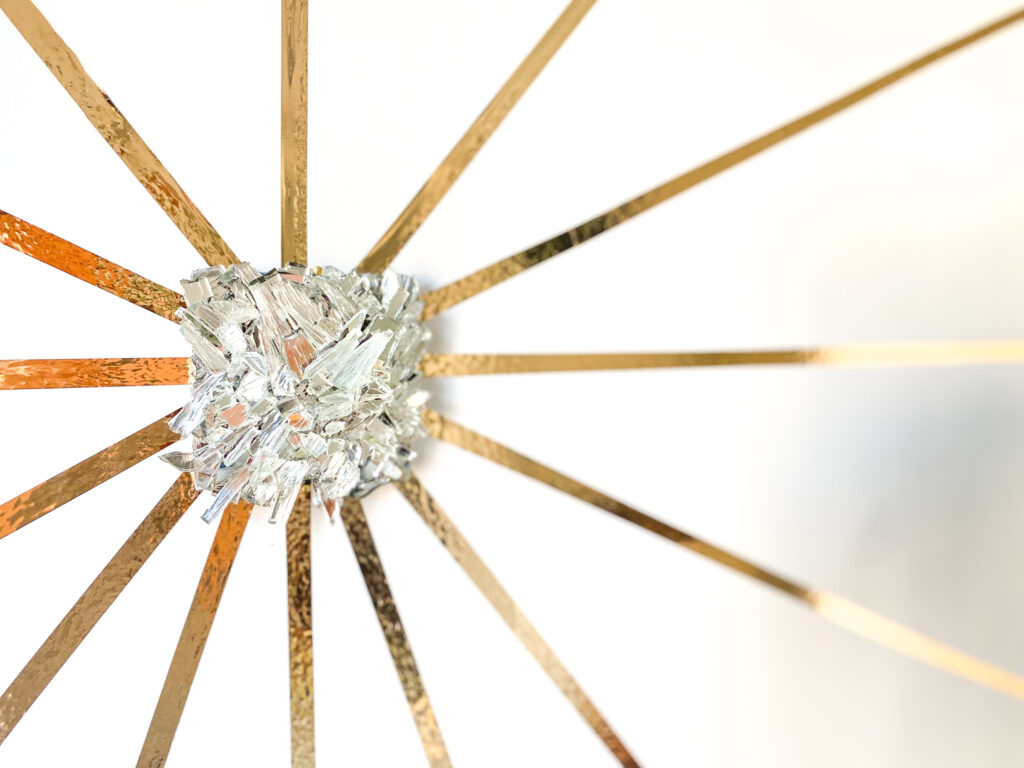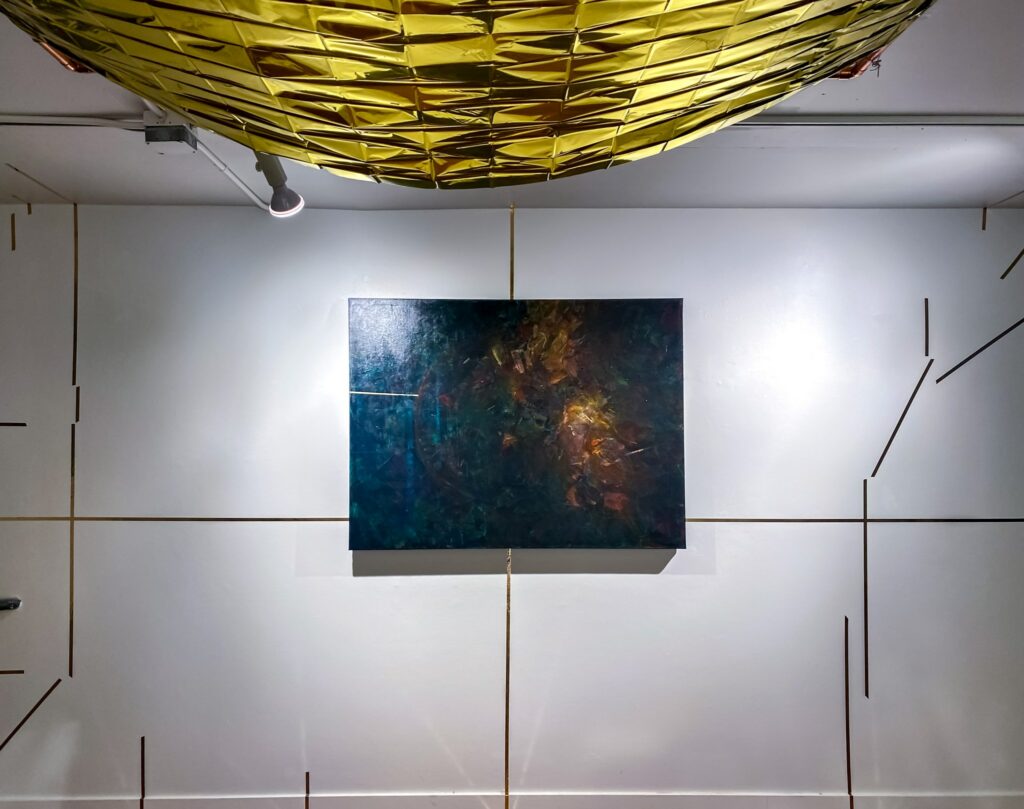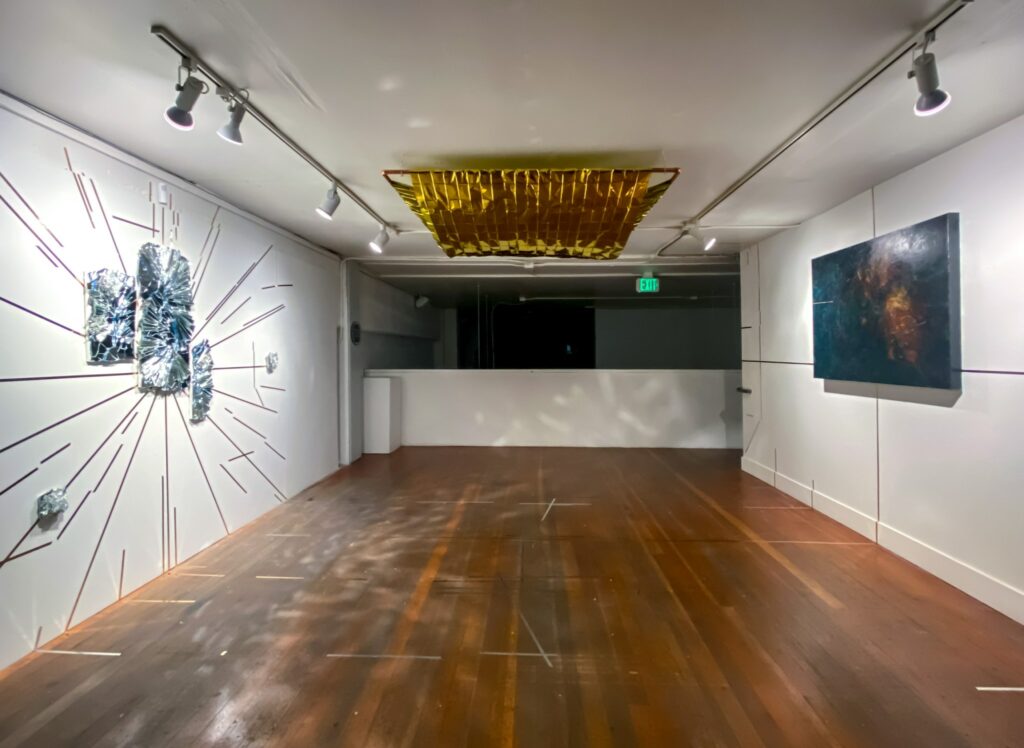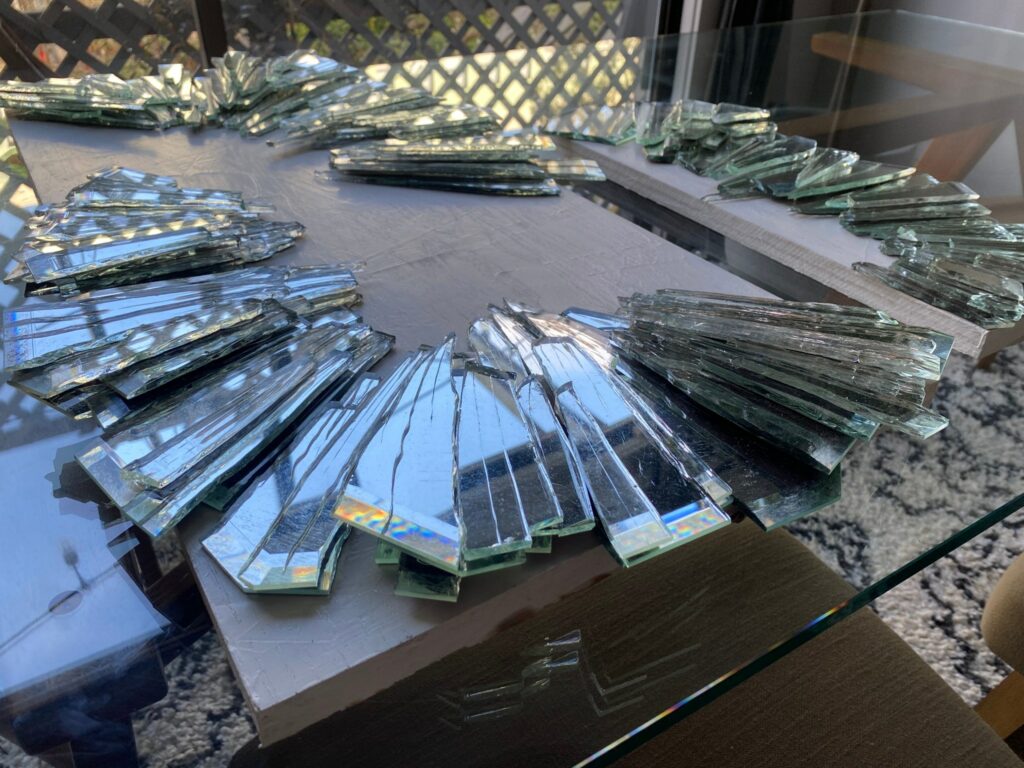
Without The Stars, There Would Be No Us imagines the cosmos in expansion, accreting astronomical objects to produce the celestial bodies that we see today. Mirror sculptures on mylar grids reference the farsighted view of Lee Bul’s Civitas Solis II, modeling proportions of time and space that the human mind can only dream of, while demarcating the longings and limits of our civilization. Within this installation, Dying Red speculates on the end of heliocentrism in our solar system – and life on Earth as we would know it. These encounters reflect the banality of human exceptionalism and the significance of meaning-making in a universe where our lives are merely cosmic dust.
I had the honor of interviewing Wang after seeing her exhibition in person. I was captivated by the way light glistened off the gold mylar and intricately fragmented mirror-work. I caught glimpse of my reflection warped in these shards and found myself humbling mouthing the question “how?” Wang has found a way to reorder everyday materials into evocative compositions mirroring the ways in which our universe has been engineered from similarly modest building blocks (carbon, hydrogen, oxygen, silicon). Without The Stars, There Would Be No Us is a beautifully articulated microcosm of the macrocosm. Read below to learn more about Melissa Wang’s ethos and process – Chanell Stone

Chanell Stone (Exhibitions Fellow): How did you arrive at this area of focus in your work? I’m very taken by these broad concepts you’re investigating.
Melissa Wang (Studio Artist): My critical praxis began in 2011. I started a PhD program in literature, where I studied science-fiction before segueing into tech. When I quit tech in late 2019 to pursue art-making, I began reading science-fiction again. Like other speculative feminists, I am drawn to the myriad futurities that are possible in a precarious and evolving world. These are not abstract notions, but prescient responses to the kinds of human exceptionalism that have fueled global crises like climate change and the pandemic.
Space is a hyperreality – a place between the real and the imaginary. For most of us, going into space is not possible; therefore, it exists as a place of becoming, where our hopes and fears can turn into dreams or nightmares. If we could experience space, would we revel in our newfound freedom? Or would we be gripped by fear, longing for Earth?
CS: Can you explain your migration between painting and installation?

MW: I treat painting like a formal exercise and installation as a thought experiment. My compositions begin as gestural works and follow the way a color, shape or line overlaps another. These edges enable me to create what Sarah Sze calls a delicate equilibrium or fragile tension – and are a recurring pattern across all my mediums. There is a transition that occurs when the viewer looks at my painting, which has its own visual language that is purely imaginary, to that of my mirror sculptures. The mirrors refract light, creating a floor pattern that looks painterly. Each artwork activates a different spatial logic for the viewer, creating opportunities for decision- and meaning-making. In an installation, there is an attempt to embody an overall experience rather than distinct philosophical or material concepts.
CS: How was it working with mirror shards? Tell me more about this piece and this process.
MW: Mirrors are rich in symbolism, seen as projections or portals. Breaking them subverts the illusion of the ideal. The edges have a natural form akin to crystals; this made assembling them into sculptures intuitive and remarkably easy. Their shininess is alluring, attesting to the power of self-referential imagery. While making these, I discovered Lee Bul’s Civitas Solis II, which references a bird’s-eye view of a cityscape. Her use of reflective and repetitive surfaces inspired me to design the mylar grid and solar sail to amplify the shininess of the mirrors.

CS: How has creating a full scale installation affected your art practice? Do you enjoy thinking and working spatially?
MW: Technically, I have never produced this many mixed-media artworks, so there was a lot of hardware and hanging consultation. If it wasn’t for my engineer husband, I’m pretty sure the solar sail would still be on the floor. Conceptually, I made major revisions to the design, including removing a gold foil floor that took eight hours to lay down. The solar sail (made of mylar space blankets and copper piping) was a last-minute addition – the idea came from a science-fiction short story about a flimsy but sturdy “sail” used to refract sunlight and power a city. It was a nod to the small but mighty feats of humans in space. Overall, the tactility of experimentation and spontaneity of DIY hacks in response to spatial limitations made for an innovative and exhilarating experience. There were many times when I said, “Let’s just see how this goes.”
CS: The way light travels in your exhibition is amazing. It is modified and abstracted from the walls to the ceiling quite beautifully. Can you explain a bit more about light as a medium and a concept?
MW: The speed of light is one of the few constants in the universe. When light travels, it appears as a line unless disturbed by cosmological interference. Originally, I designed the mylar grid to look like a traditional perspective grid. Once in the actual space, it took on a completely new life. Extending it to the floors and ceilings enabled me to capture, reflect and refract light intentionally and at multiple angles. I wanted the viewer to feel surrounded by light and all its beautiful permutations.
CS:I feel many of us are so bombarded by the weight of sociopolitical turmoil that we simply don’t take the time to look up at the sky. What is it about the cosmos that captivates you?

MW: Stars belong to everyone. They have been depicted in cave paintings and offered ancient civilizations an observable realm apart from Earth. They are formative to humankind’s development of consciousness, including the promise of an eternal form: the spirit or soul.
Theorists note that when Martin Luther King, Jr. said: “the arc of the moral universe is long, but it bends towards justice,” he was remarking on the scope and scale of liberation. When we look at the stars, we are processing data from millions of light-years away. The star may already be dead but the light has finally reached us, despite the mathematical odds of cosmic interference that could have disturbed, refracted or reflected it elsewhere. The ability to envision liberation in not just our lifetime, but the next and next, extends to the horizon, where we can see the curvature of Earth. This is what it takes to shift humanity to a kinder place.
We are all inhabitants of Earth, born from cosmic dust. At this moment of intense Sinophobia and the continued dehumanization of Black, Brown and Indigenous communities in the US, I am less interested in narratives of belonging and more in becoming who we are and meant to be.
CS: Congratulations on this beautiful exhibition Melissa! I admire the resiliency of artists like yourself during this pandemic. Out of curiosity, how are you holding up and what is next for you?
MW: It’s been tough to say the least. Very early on in 2020, I had a family member pass from Covid-19. During the week that I installed my work, my father-in-law was in the ICU. I often think of my family and ancestry – Asians and Asian-Americans only one or two generations removed – who survived unimaginable horrors of war and civil strife. They were ordinary people forced to endure extraordinary situations. Similarly, this pandemic has created a lot of unsung heroes. I am nourished by the fact that art continues to be a vehicle for expressing untold stories and capturing life during these times. And, if I have made something beautiful or meaningful that my loved ones can be proud of, that’s good enough too. As for what’s next, I am working on a new series of paintings and would love to do another installation by the end of this year.
Melissa Wang’s solo exhibition Without the stars, there would be no us is on view online in the Frank-Ratchye Studio Artist Project Space at Root Division from February 1st – 27th.
